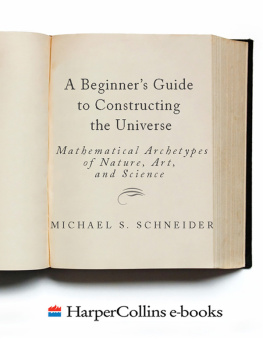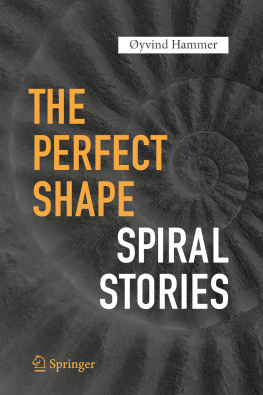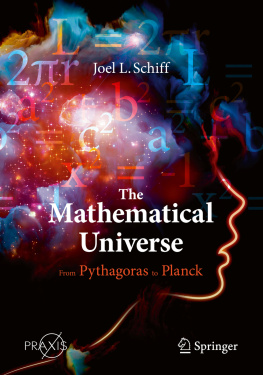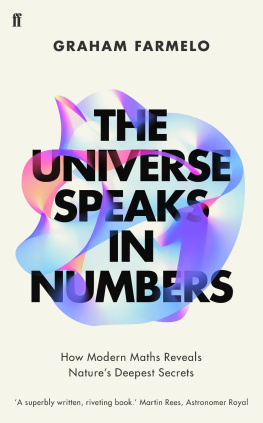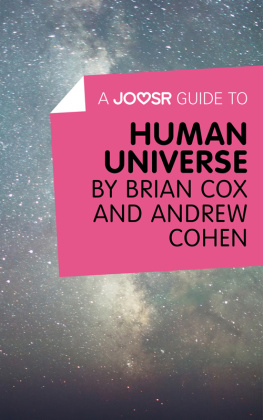guidance, and encouragement .
A universal beauty showed its face;
The invisible deep-fraught significances,
Here sheltered behind forms insensible screen,
Uncovered to him their deathless harmony
And the key to the wonder-book of common things.
In their uniting law stood up revealed
The multiple measures of the uplifting force,
The lines of the World-Geometers technique,
The enchantments that uphold the cosmic web
And the magic underlying simple shapes.
Sri Aurobindo Ghose (18721950,
Indian spiritual guide, poet)
Number is the within of all things.
Attributed to Pythagoras (c. 580500 B.C .,
Greek philosopher and mathematician)
The earth is rude, silent, incomprehensible at first,
nature is incomprehensible at first,
Be not discouraged, keep on,
there are divine things well envelopd,
I swear to you there are divine beings
more beautiful than words can tell.
Walt Whitman (18191892, American poet)
Education is the instruction of the intellect in the laws of Nature, under which name I include not merely things and their forces, but men and their ways; and the fashioning of the affections and of the will into an earnest and loving desire to move in harmony with those laws.
Thomas Henry Huxley
(18251895, English biologist)
Id like to express my sincere appreciation and thanks to the good people who produced this book at HarperCollins, especially my hardworking editors Rick Kot, Alice Rosengard, and Eamon Dolan, and copy editor Jeff Smith. Id also like to thank Nancy Singer for helping celebrate geometry in the way she designed the book, and Gail Silver for her insightful page layout. And many thanks to my astute agents, Katinka Matson and John Brockman.
I especially wish to express my gratitude to John Michell, whose books, lectures, friendship, intelligence, humor, and vision have inspired me and many others to explore the harmony in numbers and shapes and who generously gave this book its main title and preface.
The works of many people from the deep past and immediate present have impassioned my interest in this subject, and I would like to acknowledge my debt to many including Keith Critchlow, John Anthony West, Robert Lawlor, Matila Ghyka, D. W. Thompson, T. A. Cook, Jay Hambidge, M. C. Escher, R. Buckminster Fuller, David Fideler, Jean and Katherine LeMe, Rupert Sheldrake, Rachel Fletcher, R. A. Schwaller de Lubicz, Sri Aurobindo, Pythagoras, and Plato, as well as the artisans and architects of ancient Egypt and Greece who knew how to make harmony visible.
For years of deeply interesting conversation, fun, friendship, love, and support Id like to offer warm thanks and love to my brother, Jeffrey, and my parents and to my friends who live in the canyons on that island off the mainland, New York City, especially Naomi H. Cohen, Jim Pittman, Libby Reid, Barbara Crane, Charlie and Evelyn Herzer, Mark Hasselriis, and June Cobb of the Sacred Geometry Library at the Cathedral of St. John the Divine. To my friends embraced by the wide sky and natural order of Baker, Nevada, heartfelt thanks for the perpetual welcome and the tools with which to learn, including Ralph M. DeBit, Anita Hayden, and Jim Dalton. Id also like to thank my friends, fellow educators, and students for sharing a dozen lovely years in the greenery of Gainesville, Florida.
Id like to remember my teachers, who tried as best they could to get me to like math, and my many students in geometry workshops, from whom I have learned so much.
And I wish to express my wonder and thanks to nature, whose geometric jewelry adorns the world.
John Michell
Sooner or later there comes a time in life when you start thinking about Reality and where to find it. Some people tell you there is no such thing, that the world has nothing permanent in it, and, as far as you are concerned, consists merely of your fleeting experiences. Its framework, they say, is the random product of a natural process, meaningless and undirected.
Others believe that the world was made by a divine Creator, who continues to guide its development. This sounds a more interesting idea, but, as skeptics point out, every religion and church that upholds it does so by faith alone. If you are naturally faithful and can accept without question the orthodoxy of your particular religion or system of beliefs, you will feel no need to inquire further and this book will appear superfluous. It was written for those of us who lack or have lost the gift of simple faith, who need evidence for our beliefs. We cannot help being attracted by the religious view, that the world is a harmonious, divinely ordered creation in which, as Plato promised the uninitiated, things are taken care of far better than you could possibly believe. Yet superficially it is a place of confusion and chaos, where suffering is constant and the ungodly flourish.
This is where we begin the quest for Reality. Looking closely at nature, the first insight we obtain is that, behind the apparently endless proliferation of natural objects, there is a far lesser number of apparently fixed types. We see, for example, that through every generation cats are cats and are programmed for catlike behavior. In the same way, every rose has the unique characteristics of a rose and every oak leaf is definitely an oak leaf. No two specimens of these are ever exactly the same, but each one is clearly a product of its formative type. If it were not so, if animals and plants simply inherited their progenitors characteristics, the order of nature would soon dissolve into an infinite variety of creatures, undifferentiated by species and kinships.
This observation, of one type with innumerable products, gives rise to the old philosophical problem of the One and the Many. The problem is that, whereas the Many are visible and tangible and can be examined at leisure, the One is never seen or sensed, and its very existence is only inferred through the evident effect it has upon its products, the Many. Yet, paradoxically, the One is more truly real than the Many. In the visible world of nature all is flux. Everything is either being born or dying or moving between the two processes. Nothing ever achieves the goal of perfection or the state of equilibrium that would allow it to be described in essence. The phenomena of nature, said Plato, are always becoming, never actually are. Our five senses tell us that they are real, but the intellect judges differently, reasoning that the One, which is constant, creative, and ever the same, is more entitled to be called real than its ever-fluctuating products.

